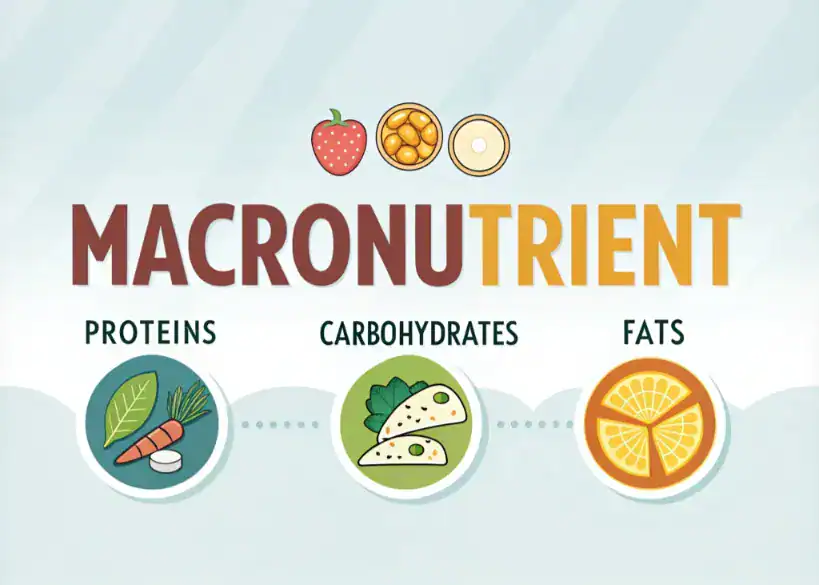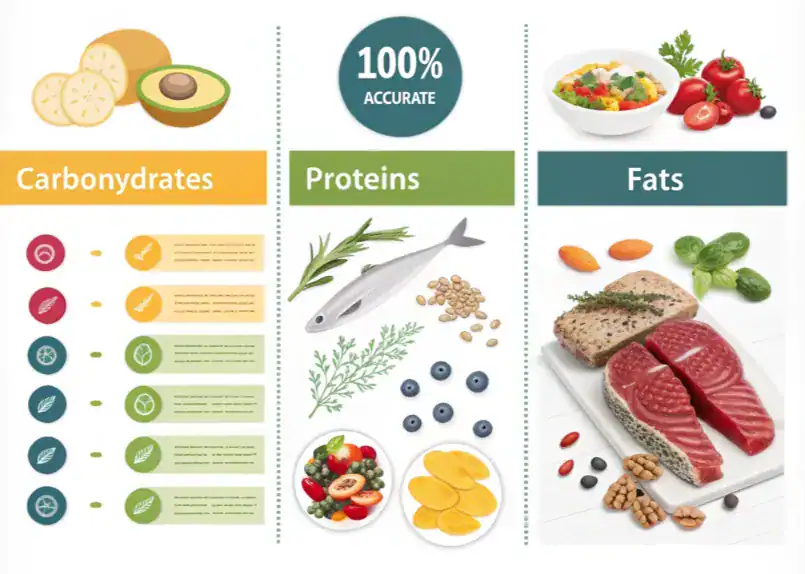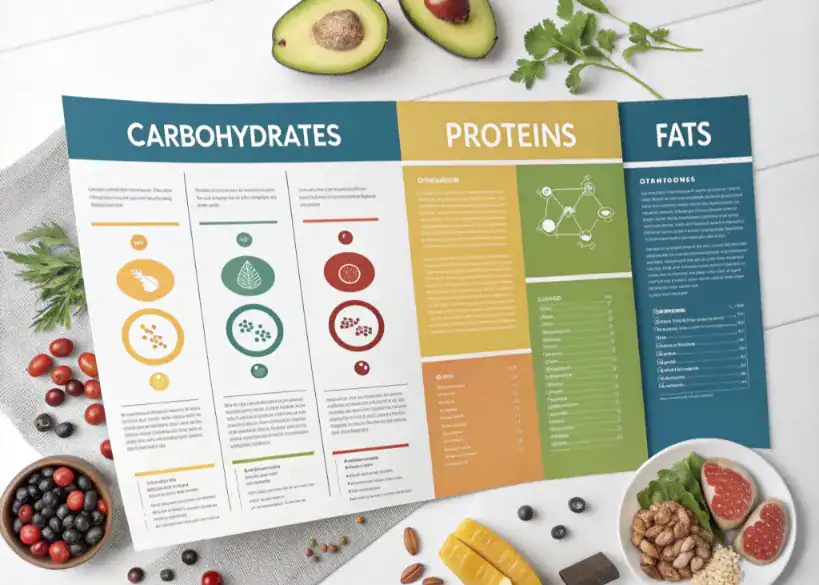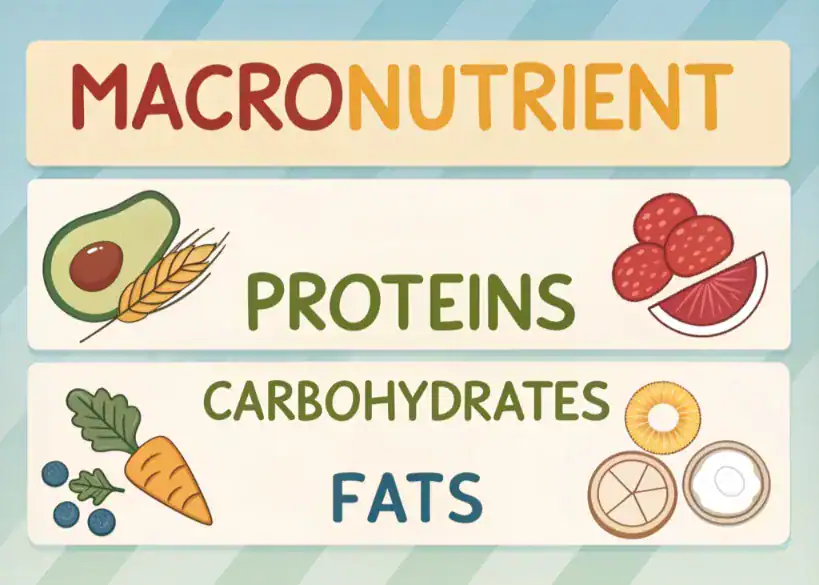Macro calculators are essential for anyone looking to improve their nutrition and achieve fitness goals. Tracking your macronutrient intake can greatly affect your body’s performance and composition. Whether your goal is weight loss, muscle gain, or overall health, understanding your macronutrients—proteins, fats, and carbohydrates—is key.
Studies show that precise macronutrient tracking leads to better weight management and muscle development. A macro cA macro calculator personalizes your diet to boost energy and support metabolism.
This guide covers macro calculators, their benefits, how to use them effectively, and practical examples to help you get started.
🎯 Key Takeaways
- Understand macronutrients and their role in your fitness journey
- Learn how to use macro calculators effectively
- Discover personalized nutrition strategies
- Implement practical meal planning techniques
- Avoid common macro counting mistakes
What Are Macros?

Macronutrients (or “macros”) are the three primary nutrients your body needs in large amounts:
| Macronutrient | Calories per gram | Primary Functions |
| Proteins | 4 | Muscle repair, tissue building |
| Carbohydrates | 4 | Energy production, brain function |
| Fats | 9 | Hormone production, nutrient absorption |
Learn more about macronutrient breakdowns for optimal health.
Calculate Your Macros using our Tool
Use our advanced macro calculator to determine your ideal macronutrient ratios:
Macronutrient Calculator for Weight Loss
Your Daily Macronutrient Targets for Weight Loss:
Quick-Start Guide to Using Macro Calculators
Getting started with macro calculators is simple. Here’s a quick guide:
- Input Personal Details: Provide accurate information about your age, height, weight, and gender.
- Specify Activity Levels and Goals: Select your physical activity level and set your fitness goals (e.g., weight loss, muscle gain, maintenance).
- Calculate Macronutrient Needs: Use the calculator to compute your daily calorie and macronutrient requirements.
- Interpret the Results: Review your personalized nutrition plan, including daily caloric intake and macronutrient breakdown.
- Implement Your Plan: Incorporate these macronutrient targets into your daily meal planning.
Types of Macro Calculators
1. Basic Calculators
- Simple input requirements
- Standard equations
- Best for beginners
- Quick estimates
2. Advanced Calculators
- Detailed customization options
- Multiple formula choices
- Activity level adjustments
- Goal-specific calculations
3. App-Based Calculators
- Real-time tracking
- Food database integration
- Progress monitoring
- Social features
Discover more about proper nutrition planning
Types of Macro Calculators

There are various types of macro calculators available to suit different needs:
- Basic Macro Calculators: Require minimal input and use standard equations.
- Advanced Macro Calculators: Offer more customization with detailed input options.
- Personalized Macro Calculators: Provide individualized nutrition plans based on comprehensive personal data.
- App-Based Macro Calculators: Mobile apps with additional features like diet tracking and workout plans.
Comparison of Macro Calculator Types
| Type | Features | Best For |
| Basic Macro Calculators | Simple inputs, standard equations | Beginners |
| Advanced Macro Calculators | Detailed inputs, sophisticated equations | Intermediate users |
| Personalized Macro Calculators | Comprehensive data, tailored plans | Advanced users seeking precision |
| App-Based Macro Calculators | Mobile access, extra features | On-the-go tracking enthusiasts |
How to Use a Macro Calculator
- Input Personal Details
- Age
- Height
- Weight
- Gender
- Activity level
- Set Your Goals
- Weight loss
- Muscle gain
- Maintenance
- Performance
- Adjust for Activity Level
- Sedentary
- Lightly active
- Moderately active
- Very active
- Extremely active
Check out our guide on counting macronutrients
How to Use a Macro Calculator: Practical Examples
Example 1: Weight Loss Goal
Scenario: Sarah, a 30-year-old female, wants to lose weight.
- Personal Details:
- Age: 30 years
- Height: 165 cm
- Weight: 70 kg
- Gender: Female
- Activity Level: Moderately active
- Goal: Lose 0.5 kg per week
Calculation: Using an advanced macro calculator, Sarah inputs her details. The calculator estimates her Total Daily Energy Expenditure (TDEE) and suggests:
- Daily Caloric Intake: 1,500 calories
- Macronutrient Breakdown:
- Protein: 113g (30%)
- Carbohydrates: 150g (40%)
- Fats: 50g (30%)
Example 2: Muscle Gain Goal
Scenario: Mike, a 25-year-old male, aims to build muscle.
- Personal Details:
- Age: 25 years
- Height: 180 cm
- Weight: 75 kg
- Gender: Male
- Activity Level: Very active
- Goal: Gain 0.25 kg muscle per week
Calculation: Mike uses a personalized macro calculator and finds:
- Daily Caloric Intake: 2,800 calories
- Macronutrient Breakdown:
- Protein: 210g (30%)
- Carbohydrates: 350g (50%)
- Fats: 93g (30%)
Sample Meal Plans
For Weight Loss
Breakfast:
- Oatmeal with berries and a scoop of protein powder.
Lunch:
- Grilled chicken salad with mixed greens and olive oil dressing.
Dinner:
- Baked salmon with steamed vegetables and quinoa.
Snacks:
- Greek yogurt with honey.
- A handful of almonds.
For Muscle Gain
Breakfast:
- Scrambled eggs with whole-grain toast and avocado.
Lunch:
- Turkey sandwich on whole-grain bread with a side of sweet potato.
Dinner:
- Lean beef stir-fry with brown rice and vegetables.
Snacks:
- Protein shake.
- Cottage cheese with pineapple.
Benefits of Using a Macro Calculator

- Customized Nutrition Plans: Tailored to your specific needs.
- Improved Goal Achievement: Structured approach aids in reaching fitness goals.
- Better Understanding of Nutritional Needs: Educates on macronutrient importance.
- Flexible Approach to Dieting: Allows for variety within macro targets.
- Simplified Meal Planning: Provides a framework for daily meals.
Frequently Asked Questions (FAQ)
Q1: Do I need to count macros every day?
A:While daily tracking can be beneficial, it’s important to avoid becoming obsessive. Use macro counting as a guide rather than a strict rule.
Q2: Can macro calculators account for medical conditions?
A:Some personalized calculators can consider certain medical conditions, but it’s best to consult a healthcare professional for tailored advice.
Q3: How often should I adjust my macros?
A:Reassess your macros every few weeks or when you notice changes in your weight or activity level.
Q4: Are there macros I should prioritize?
A:The balance depends on your goals. For muscle gain, prioritize protein; for endurance activities, focus on carbohydrates.
Q5: Can I use macro calculators for a ketogenic diet?
A:Yes, many calculators allow you to set specific macro ratios suitable for ketogenic or other specialized diets.
Macro Tracking Checklist
- Set Clear Goals: Define your fitness objectives.
- Choose the Right Calculator: Select one that suits your needs.
- Accurately Input Details: Ensure all personal data is correct.
- Plan Meals Accordingly: Use the macronutrient breakdown to plan meals.
- Monitor Progress: Regularly assess progress and adjust as necessary.
- Stay Flexible: Adapt your plan based on how your body responds.
Common Mistakes to Avoid
❌ Not measuring portions accurately
❌ Forgetting to track beverages
❌ Inconsistent tracking
❌ Ignoring fiber intake
❌ Not adjusting macros as needed
Success Stories
“Using a macro calculator helped me lose 30 pounds while maintaining muscle mass. It’s not just about calories – it’s about the right balance of nutrients.” – Sarah M.
“I finally broke through my plateau by properly tracking macros. The calculator helped me understand where I was going wrong.” – John D.
Read more success stories about proper nutrition
Quick-Start Guide
- Calculate your maintenance calories
- Determine your goal (cut, bulk, maintain)
- Set protein (1.6-2.2g/kg bodyweight)
- Allocate remaining calories to carbs and fats
- Track and adjust based on results
Get started with our meal planning guide
Sample Meal Plans
Weight Loss Plan (1800 calories)
- Breakfast: Protein oats with berries
- Lunch: Chicken salad with avocado
- Dinner: Salmon with quinoa and vegetables
- Snacks: Greek yogurt with almonds
Future Trends
- AI-powered macro adjustments
- Real-time tracking integration
- Personalized recommendations
- Wearable device synchronization
Resources and Tools
Conclusion
Macro calculators are powerful tools for achieving your fitness goals. Remember to:
- Start with accurate measurements
- Be consistent with tracking
- Adjust based on results
- Focus on whole foods
- Stay patient and persistent
Get more nutrition tips and advice
Disclaimer: Always consult with healthcare professionals before starting any new diet or exercise program.
Resources
- National Institutes of Health (NIH) – Office of Dietary Supplements https://ods.od.nih.gov/
- Academy of Nutrition and Dietetics https://www.eatright.org/
- American Society for Nutrition https://nutrition.org/
- Harvard T.H. Chan School of Public Health – Nutrition Source https://www.hsph.harvard.edu/nutritionsource/
- Mayo Clinic – Nutrition and Healthy Eating https://www.mayoclinic.org/healthy-lifestyle/nutrition-and-healthy-eating/basics/nutrition-basics/hlv-20049477
- World Health Organization (WHO) – Nutrition https://www.who.int/health-topics/nutrition
- U.S. Department of Agriculture (USDA) – Nutrition https://www.nutrition.gov/
- American Heart Association – Healthy Eating https://www.heart.org/en/healthy-living/healthy-eating
- Centers for Disease Control and Prevention (CDC) – Nutrition https://www.cdc.gov/nutrition/
- International Society of Sports Nutrition https://www.sportsnutritionsociety.org/
As a veteran fitness technology innovator and the founder of GearUpToFit.com, Alex Papaioannou stands at the intersection of health science and artificial intelligence. With over a decade of specialized experience in digital wellness solutions, he’s transforming how people approach their fitness journey through data-driven methodologies.
